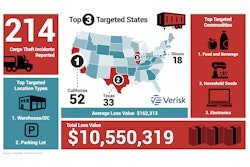Exiting FMCSA head (right) chats with New York Congressman Richard Hanna.
Wrapping up five-years on duty at the wheel of the Federal Motor Carrier Safety Administration, Anne Ferro says she wouldn’t do anything differently: She’s worked to implement Obama administration policy within the framework of the agency’s mandate and legal authority, and that includes keeping a wide range of truck safety initiatives – many of which were already underway – on the road to implementation.
“That’s the agenda we deployed and I’m very proud of it,” Ferro says. “I don’t have a ‘what if’ or a ‘think back’ or ‘would I place things differently.’ It’s the agenda I came in to apply.”
Set to leave office Aug. 24, Ferro sat down last with with a dozen trucking and transportation journalists for a farewell interview. FMCSA provided a summary sheet of her “accomplishments,” though Ferro credited the agency’s senior career staff and “deep leadership bench” for moving the regulatory initiatives forward.
The agency is expected to announce an interim leadership plan next week ahead of Ferro’s departure. The Department of Transportation reported July 25 Ferro was stepping down to become president and CEO at the American Association of Motor Vehicle Administrators.
On Compliance, Safety, Accountability:
“Clearly, CSA has been a game-changer from the get-go. It has put safety in the boardroom. It has put the safety manager at the table. It has created a conversation between the company owner and drivers that was not in place in before. And it has given the public, users and competitors clearer access to the information on other companies’ performance than ever before. So it has paved the way for significant change. It’s a program that continues to improve.”
On the hours-of-service rule change, and industry pushback:
“Anyone who’s going to set a constraint on an individual’s or a company’s ability to fulfill their customers’ need is going to face some resistance. They want the maximum flexibility. As individuals we think we know what we can do. But in an economic system that tries to drive the last penny out of the supply chain, the transportation sector, freight movement – and trucking in particular – gets squeezed the hardest. It’s highly fragmented, it’s highly competitive and it’s highly mobile. That tension will always bump up against an hours-of-service rule. It’s not just myself and the prior two or three [FMCSA] administrators, it’s 80 years’ back.”
“And when we say ‘the industry’ [resists HOS], we are overstating the case. There are large numbers of drivers who would vastly prefer to see an hours-of-service structure that recognized their personal demand to get rest and to be treated properly – to work within a more manageable system. Seventy hours is still a week and three-quarters compared to what most Americans are working. There are segments [of the trucking industry] that have a very loud voice, that are expressing the kinds of problems that come with change. I’m saying let’s press forward with that change. And go on with the next iteration.”
On driver coercion:
“The coercion rule is really exciting, but I can’t talk about specifics in the proposal [at this stage of the rulemaking process]. But it was an impressive piece of MAP-21 that recognized the impact that supply-chain influencers have on the driver. It’s the first time there’s been a clear reach in our safety mandate into shipper behavior, broker behavior, and others outside our immediate regulatory oversight structure. More to come.”
“The rule is not a silver bullet. The issue of shipper treatment of drivers is something that can be addressed today. Trucking supply is on the strong side of the equation. There is more demand for trucking services than there is supply. That allows room for rate growth, for driver compensation growth, for investment in safety growth. Shippers that are abusive, frankly, should be shut out. It’s the same logic of getting the bad actors out of the business.”
On chameleon carriers:
“This idea of being able to keep cycling back into the industry and avoid safety enforcement or penalties is part of what continues to drive rates to the bottom rung, and continues to drive quality to the lowest common denominator. We’ve got to raise that denominator to the bar where a lot of good operators are already practicing, and stop forcing them to compete against folks that are cutting corners on safety.”
On drivers:
“I knew this coming in but I feel it more strongly now: The vast majority of drivers out there are professional, they are passionate about their work and they are really good at their work. And they want the best safety outcome.”
On criticism:
“It’s not about me, it’s about the position. It’s not Anne Ferro they’re criticizing, it’s the administrator of the FMCSA. The administrator is not here to make friends. The administrator is here to fulfill the letter of the law and to carry out the administration’s perspective.”
On her tenure:
“I look back on five years with a great deal of pride and satisfaction, energized by not just what we’ve done but what’s to come.”








